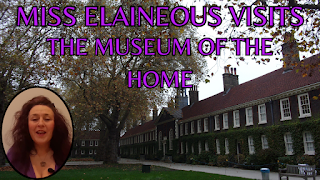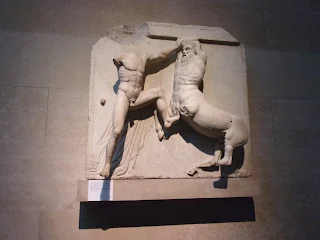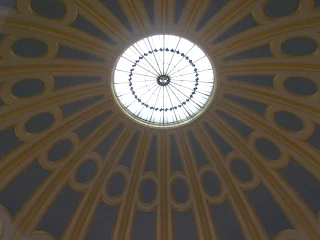Sir John Soane (1753-1837) was considered to be the finest English architect of his time, specialising in the Neo-Classical style. Soane was responsible for such imposing buildings as the Bank of England in Threadneedle Street (now largely destroyed) and Dulwich Picture Gallery.
The museum is situated at numbers 12, 13 and 14 Lincoln's Inn Fields, Holborn, London, and Soane both resided and worked here. He remodelled his three houses and turned them into a co-joining living museum, designed to display his collection of unusual artefacts.
The museum was established in Soane's lifetime.
Here's the front of the museum. It's the second time I've been here, but the first that photography's been allowed; albeit without a flash.
The first room we ventured into was the Library-Dining Room, and generally speaking it was quite gloomy indoors.
This room is so called as the Dining Room is attached to the Library...
This astronomical clock- also known as an orrery- is French and dates from c.1800. There is also a Vain Old Tart in the photo...
The collection also contains works by Canaletto and Turner.
The Dome Area, and the collection is both bizarre and spectacular, and includes this central statue: Cast of the Apollo Belvedere.
You will find that you keep walking back on yourself.
Here's a view down through an oddly-shaped rectagular hole...
It was possibly my favourite room in the museum.
The view outside onto a small courtyard...
In the Foyle Space is an art collection by Lina Iris Viktor.
This statue, Web Weaver speaks of female creative power and African sculptural traditions.
This is a SuperDean photograph- mine didn't come out half as well!
These gold and black canvases evoke the night sky.
I loved these glittering, gold artworks. I would- I'm like a magpie when it comes to sparkly things!😁
Beautiful stained glass; yet in its own way it's quite freaky! Maybe it's that juxtaposition with the light reflecting through the general gloomth of the museum...
The Monk's Parlour was freaky, with stained glass windows and gargoyles standing sentinel on the wall, but the light was soooo low it was hard to get a decent picture...
Grainy Monk's Chamber view...
Handsome, aren't they?! It looks like a rogues' gallery of my ex-boyfriends!
I moved down into Crypt.
The way this is set out springs to mind a macabre game of chess!
On both of my visits here, whilst walking through this structured maze, I kept coming eyeball to eye-hole with this skull on a shelf.
The way I kept ending up next to the skull was disconcerting, to say the least. But he's actually a plaster model- possibly cast- of a human skull, and not the real thing.
The Sepulchral Chamber and, down on this level, you can walk right up to the sarcophagus of Egyptian pharaoh, Seti I...
...You can even step up and peer inside at the hieroglyphics...
This place was like a labyrinth with elements of halls of mirrors...
It is very important to look up and down, as all the levels are interlinked and you can get a different view of something you walked past five minutes ago...
There's more art by Lina Iris Viktor down in the basement.
Situated between two plaster casts of the Venus de Medici is the statue Nbiru, and she constrast sharply with traditional representations of the female form.
Ritual Thrones flanking a statue of Britannia. This speaks of the way in which objects embody power.
Kitchen sink, and the kitchens are also down here in the basement...
Kitchen range...
This old kitchen was "normal" in comparison to what I'd seen so far!
Second kitchen range...
Models of Soane's work are secreted in the museum. This wooden model is for Butterton Hall, Staffordshire; which was never built.
Downstairs courtyard view...
50 casts from ancient gems, made by Nathanial Marchant (1739-1816). He was a prolific gem engraver, and these are c.1792/3.
Up into the North and South Drawing Rooms; all spaces previously used by John Soane, on the top floor...
This area is elegant, and certainly looks more habitable than the rooms housing the majority of the collection!
The museum was free to enter, and this area was once only accessible via a tour.
More Lina Iris Viktor artworks are on display upstairs in the Front Gallery...
The collection contains sculpture, painting, photography and gilding...
It uses mixed media: bronze, wood, silk and ceramic.
The collection unearths connections across time and culture...
It's also home to the Hardy Tree (or rather what's left of it!) and I've blogged about it, link:-
http://elainerockett.blogspot.com/2017/09/miss-elaineous-visits-st-pancras-old.html
I thoroughly enjoyed my visit to Sir John Soane's Museum, and now want to go and see Dulwich Picture Gallery!
All in good time...
Ta ta for now,
Miss Elaineous
XXXXXXXXXXXXXXXXXXXXXXXXXXXX
XXXXXXX
X
XXXXXXX
X









































































